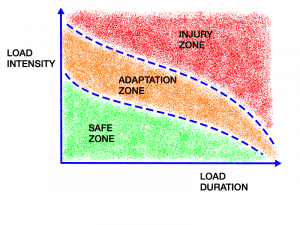
Injury Prevention and Load Management
Injury Prevention and Load Management

Load management is a critical concept to understand for anyone participating in physical activity, whether it be gardening, housework, physical work, gym training, general exercise, social sport or even professional sport.
When we talk about load, we are talking about the stress the body is subjected to during a particular activity. The load can vary in intensity and also in duration. Sprinting would be an example of higher intensity load compared to walking which would be considered lower intensity. The load duration is simply the length of time that the body is subjected to the given stress. Total load is a combination of these variables, for example, if a high intensity activity is only performed for a short period of time, it is considered a relatively low total load. However, if a high intensity activity is performed for a long period of time it is considered a high total load. It is important to remember that a given activity may be highly intense for one individual and low to moderately intense for others. For example a marathon runner would consider a 5Km run very easy, however an untrained person would potentially find it very intense.
Every part of our musculo-skeletal system (muscles, tendons, ligaments, bones, etc.) responds to load. If we under load our musculo-skeletal system, the tissue quality declines. This is seen in individuals that undergo periods of bed rest and experience rapid muscle loss as a result. What we don’t see is that our tendons, ligaments, bones, etc are also affected. If we overload our musculo-skeletal system, we rapidly increase our chance of injury. This can be seen when untrained individuals decide to run marathons and end up with injuries.
So what’s the secret to preventing injuries?
If you load your body in it’s safe zone as seen in the graph, you are likely to remain in a state of homeostasis. This means your musculo-skeletal system is perfectly happy and capable of tolerating the given load. Unfortunately, you are unlikely to undergo any physiological adaptations. Ie. You will not get fitter or stronger. Your marathon runner performing a 5Km jog would be loading his body in the safe zone.
So what if I want to get stronger/fitter and avoid injuries?
If you’re honest with yourself, you should know what is a safe load and what is a dangerously high load for you. If you want to make gains in strength and fitness, you have to load your body in the adaptation zone. The adaptation zone is where you start to push the boundaries a little. Load yourself more and you risk injury, load yourself less and you won’t make any gains. Professional sporting teams pay very clever people lots of money to develop individual training programs for each of their players/athletes.
For you and I, the safest way to improve your fitness is to commence in your safe zone and gradually progress your load. A general rule of thumb is to increase your load by no more than 10% each week. If you stick to this rule, you are likely to make safe improvements in your fitness/strength. Your adaptation zone will rise up the graph and therefore your injury zone will shrink in size.
So there it is… If you want to maintain your level of fitness with very little risk of injury, exercise in your safe zone. If you want to progress your fitness with low risk of injury, exercise in your adaptation zone and make gradual progressions. If you train outside of your adaptation zone, you may see rapid improvements in fitness but you will also significantly increase your injury risk.
Important factors to keep in mind!
- Your graph will change from day to day. For example, a 10Km run may be in your adaptation zone today but if you try and repeat it tomorrow before your body has recovered, it will be in your injury zone. Even AFL footballers have rest days!
- If you have an extended period of rest, whether it is due to injury, holiday or just being lazy, your graph will change. Your body adapts negatively to the decreased loads placed upon it and as a result, you will have to ease back into your activity to avoid injury.
- Different musculo-skeletal tissues respond to load in very different ways. Muscles may recover relatively quickly but tendons generally take two to three days to recover from intense exercise. If you load them before they have recovered, your graph will be different and you will have to go easy to avoid injury.
- Biomechanical factors can influence the way your body absorbs load. If you are limping due to an ankle injury, other joints will be loaded differently, thus changing your load management graph and potentially increasing your injury risk.
- The graph applies to all types of load. If you normally spend an hour per week in the garden and suddenly spend a full day weeding, you are likely to be in the injury zone. If you normally go to the gym and spend half an hour on the bike, then decide to try a pump class, you may find yourself in the injury zone.
- Other factors such as sleep, stress, diet, general health and mood can influence how the body responds to load.
It shouldn’t be surprising now that spikes in load such as pre-season training or preparation for an event tend to result in a higher incidence of injuries.
Physiotherapists are experts in load management and injury prevention. If you need assistance to ensure a safe and successful return to training, make sure you contact My Physio Perth.
[…] Advice on loading/unloading […]